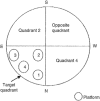Mild traumatic brain injury (MTBI) leads to spatial learning deficits
- PMID: 22360521
- PMCID: PMC3925503
- DOI: 10.3109/02699052.2011.635362
Mild traumatic brain injury (MTBI) leads to spatial learning deficits
Erratum in
- Brain Inj. 2012;26(13-14):1763. Dawish, Hala [corrected to Darwish, Hala]
Abstract
Primary objective: The aim of this study was to investigate the effect of mild and severe TBI on young male Wistar rats' spatial learning.
Research design: Randomized repeated measure experimental design was used to examine spatial learning in three independent animal groups.
Methods and procedures: Twenty-four (severe n = 9, mild n = 8, sham n = 7) male rats were included in the study. Animals received controlled mild (1.5 mm), severe (2.5 mm) cortical impact injury or sham surgery. Spatial learning was assessed daily using a modified Morris water maze test, 20 days post-trauma, for 5 consecutive days. Percentage time travelled within each quadrant and escape latency were calculated. All animals' hippocampal brain regions were examined post-injury using neuron (MAP2) and pre-synaptic protein (Synaptophysin) biomarkers.
Main outcomes and results: It took the animals with mild injury until day 3 to reach the platform; and animals with mild and severe injury spent significantly less time in the target quadrant than the sham. The hippocampal neuron numbers differed proportionately between animals with severe and mild injury, but the percentage of synaptophysin density was significantly less in the dentate gyrus of both animals with mild and severe injury than sham group.
Conclusion: Persistent spatial learning deficits exist after mild TBI; these deficits appear equivalent to deficits exhibited after a more severe injury.
Conflict of interest statement
Figures







Similar articles
-
One-year study of spatial memory performance, brain morphology, and cholinergic markers after moderate controlled cortical impact in rats.J Neurotrauma. 1999 Feb;16(2):109-22. doi: 10.1089/neu.1999.16.109. J Neurotrauma. 1999. PMID: 10098956
-
Simvastatin and environmental enrichment effect on recognition and temporal order memory after mild-to-moderate traumatic brain injury.Brain Inj. 2014;28(2):211-26. doi: 10.3109/02699052.2013.862737. Brain Inj. 2014. PMID: 24456059 Clinical Trial.
-
Time course of increased vulnerability of cholinergic neurotransmission following traumatic brain injury in the rat.Behav Brain Res. 1995 Oct;70(2):125-31. doi: 10.1016/0166-4328(95)80002-6. Behav Brain Res. 1995. PMID: 8561903
-
Relationship between learning and memory deficits and Arp2 expression in the hippocampus in rats with traumatic brain injury.World Neurosurg. 2012 Dec;78(6):689-96. doi: 10.1016/j.wneu.2011.07.042. Epub 2011 Nov 7. World Neurosurg. 2012. PMID: 22120305
-
Increased anticholinergic sensitivity following closed skull impact and controlled cortical impact traumatic brain injury in the rat.J Neurotrauma. 1994 Jun;11(3):275-87. doi: 10.1089/neu.1994.11.275. J Neurotrauma. 1994. PMID: 7996582
Cited by
-
Inhibition of HIF-1α-AQP4 axis ameliorates brain edema and neurological functional deficits in a rat controlled cortical injury (CCI) model.Sci Rep. 2022 Feb 17;12(1):2701. doi: 10.1038/s41598-022-06773-9. Sci Rep. 2022. PMID: 35177771 Free PMC article.
-
Pycnogenol protects CA3-CA1 synaptic function in a rat model of traumatic brain injury.Exp Neurol. 2016 Feb;276:5-12. doi: 10.1016/j.expneurol.2015.11.006. Epub 2015 Nov 29. Exp Neurol. 2016. PMID: 26607913 Free PMC article.
-
Mechanical injury and blood are drivers of spatial memory deficits after rapid intraventricular hemorrhage.Neurobiol Dis. 2020 Nov;145:105084. doi: 10.1016/j.nbd.2020.105084. Epub 2020 Sep 14. Neurobiol Dis. 2020. PMID: 32941979 Free PMC article.
-
Pathophysiology and Treatment of Memory Dysfunction After Traumatic Brain Injury.Curr Neurol Neurosci Rep. 2017 Jul;17(7):52. doi: 10.1007/s11910-017-0762-x. Curr Neurol Neurosci Rep. 2017. PMID: 28500417 Free PMC article. Review.
-
The utilization of small non-mammals in traumatic brain injury research: A systematic review.CNS Neurosci Ther. 2021 Apr;27(4):381-402. doi: 10.1111/cns.13590. Epub 2021 Feb 4. CNS Neurosci Ther. 2021. PMID: 33539662 Free PMC article.
References
-
- Langlois JA, Rutland-Brown W, Thomas KE. Traumatic brain injury in the United States: emergency department visits, hospitalizations, and deaths. Atlanta, GA: Centers for Disease Control and Prevention, National Center for Injury Prevention and Control; 2006.
-
- Alexander MP. Mild traumatic brain injury: Pathophysiology natural history and clinical management. Neurology. 1995;45:1253–1260. - PubMed
-
- Aubry M, Cantu R, Dvorak J, Graf-Baumann T, Johnston K, Kelly J, et al. Summary and agreement statement of the first international conference on concussion in sport Vienna (2001). Recommendations for improvement of safety and health of athletes who may suffer concussive injuries. British Journal of Sports Medicine. 2002;36:888–897. - PMC - PubMed
-
- Kim E, Lauterbach EC, Reeve A, et al. Neuropsychiatric complications of traumatic brain injury: A critical review of the literature (A report by the ANPA committee on research) Journal of Neuropsychiatry and Clinical Neuroscience. 2007;19:106–127. - PubMed
-
- Halterman CI, Langan J, Drew A, Rodriquez E, Osterring L, Chou LS, et al. Tracking the recovery of visuospatial attention in mild traumatic brain injury. Brain. 2006;129:747–753. - PubMed
Publication types
MeSH terms
Grants and funding
LinkOut - more resources
Full Text Sources
Medical
